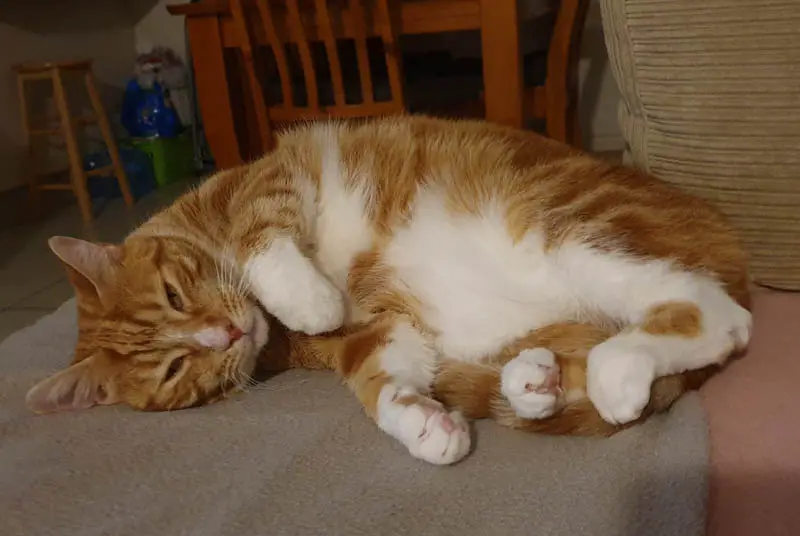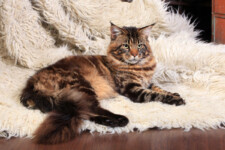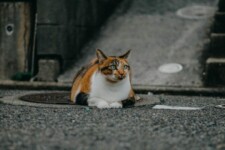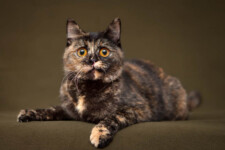Ginger & Orange Tabby Cats (Everything You Need To Know)
Ginger cats are undoubtedly some of the most popular and well-loved cats in the world.
They not only make great companions, but they have also made a considerable impact on pop culture.
Remember Garfield in Breakfast at Tiffany’s and puss in Boots?
Ginger cats are also fondly called marmalade, caramel, orange, butterscotch, butter, and yellow.
The existence of the ginger cat goes all the way to the time of Jesus. There is a tale that claims baby Jesus was comforted by an orange tabby and received blessings from Mary, the mother of Jesus.

The History of Ginger Cats
The origin of these adorable kitties can be traced back to 1950BC in ancient Egypt.
It is believed that the Egyptians might have gifted cats the character and ability to conquer and explore the world. Paintings of a ginger cat were found on a tomb made of limestone.
What Causes the Orange Color in Ginger Cats?
The ginger gene is responsible for creating the dominant red pigment.
For a ginger kitten to be born, the gene needs to be on the X chromosome.
This gene exists in two forms, ‘O,’ which creates the red pigment and ‘o,’ which does not. A female cat becomes ginger if both ‘X’ chromosome contains the ‘O’ chromosome.
A calico or ginger are produced if they contain ‘Oo.’ Male cats become ginger if they get ‘O’ chromosome from their mother. ‘o’ chromosome breeds a male tortoiseshell or a male calico cat.
Since females require the ‘O’ chromosome on both the X chromosomes, there are more male ginger cats than females. 80% of ginger cats are male.
Is Ginger Cat a Breed or a Color?
Contrary to the misconception that ginger cats are a breed, they are not. Ginger refers to the coat color.
Although most ginger cats appear in Moggies, they also appear in breeds like the American Bobtail, Munchkin, Persian, Bengal, Maine Coon, and Abyssian.
Physical Appearance
Ginger cats come in varying tints and shades of orange, cream, or red.
Most of them have a white belly and legs, and some also have white chests, paws, and tail tip.
Their hair can be long or short, and you will likely see freckles on their skin, especially on the nose and lips. The freckles develop when they are 1-2 years old.
Most ginger cats have green or gold eyes, while a substantial number have bronze. Like any other kitten, ginger cats are born with blue eyes.
Its breed determines the size of a ginger cat, however the chances of finding one weighing over 18 pounds are rare.
The average ginger cat weighs between 6-10 pounds and has a height of between 12-15 inches.
Pattern Variation
All ginger cats are indeed tabbies, but not all tabbies are gingers.
If you look at your ginger cat closely, you will see stripes, spots, or whirls. Gingers cats come in the following pattern variation.
Spotted
They have small or large spots covering their bodies. The spots are either rosettes, round or oval. These patterns are commonly found in the Bengal breed.
Ticked
This type almost appears to have a solid ginger color; however, their color nearly appears speckled. Their bodies are covered with agouti hairs while the face has tabby markings.
Mackerel
You will see an ‘M’ marking located on the forehead. This cat is striped and resembles a tiger.
Classic
A classic tabby bear resembles a marble cake. It has swirling and bold patterns on the sides. The cat is also known as a blotched tabby.
Patched
This commonly describes a tortie tabby. This cat has red and brown tabby patches, which are more profound on the head and legs.
Read all about Tortoiseshell Cats (Tortie’s) – The Lucky Cat!
Personality and Temperament
Ginger cats relaxed, happy, and have a character resembling that of a calm dog.
Ginger kittens and moggies are friendly and lovable.
They enjoy hunting mice, and so bold that they do not back down from a fight and will often approach and unfamiliar conditions with courage.
My ginger kitty (in the picture above) has to be watched carefully outside, as she will run up to dogs being walked by their owners, and start attacking them!
Yes, I’ve seen some very shocked dog owners when my little ginger girl has a swipe at their large dog.
They are also sassy and independent.
Although torties enjoy the company of humans, your ginger cat will not appreciate being ordered around.
They are not keen on having the house for themselves, they are okay sharing the home with other pets.
Their sweet behavioural traits make this cat easy to fall in love with.
You will find that ginger cats are affectionate animals who will likely spend time with their favorite person.
They are also very vocal, often making meowing with explicit tones to tell you what they want.
Feeding Habits
Ginger cats are not fussy eaters, they will eat just about everything.
However, just because your butterscotch is an easy feeder does not mean you should let them feed on anything they come across.
To maintain a healthy life, keep your cat indoors, and monitor and maintain controlled portions and feeding schedule.
If you have two or more cats, you can use an automatic cat feeder for multiple cats to control the amount of food that they eat.
Health and Exercise
With the right diet and exercise, your ginger cat will likely enjoy a lifespan of 15- 20 years.
- You should monitor the weight of your orange cat as they are prone to diabetes.
Without a proper diet and regular exercise, they might develop diseases like arthritis, diabetes, and heart diseases.
Provide plenty of interactive toys and play with your cat from time to time to keep their brain and muscles stimulated. Make regular visits to the vet as well.
How to Care for a Ginger Cat
Ginger cats are clean animals, so just brush them from time to time to get rid of extra fur, especially in summer months.
It is also important to trim their nails, brush their teeth, and watch out for wax build-up. Wax and dirt are best removed using a wet cotton bud.
Ginger cats stand out from the rest and enjoy a great admiration for their colorful and beautiful coat.
See More Of Our Cat Breeds Series
Find Out About Calico Cats (The ‘Lucky Charm’)
Have You Heard Of Lykoi Cats? (Little Warewolves!)



